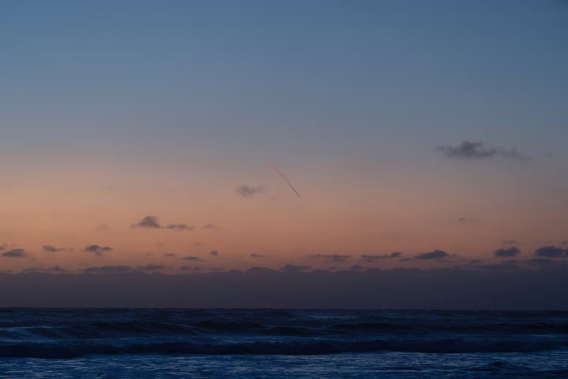
Astronomers are dismissing early sightings by stargazers of a rare comet over New Zealand skies, and say it will only be seen by the naked eye later this week.
Comet C/2023 A3 became visible in the western skies of the country last night, but could not be seen by the human eye.
Stardome astronomer Josh Aoraki told the Herald the comet was only visible on their cameras last night, but it should be more visible over the coming days.

Comet C/2023 A3 (Tsuchinshan-ATLAS) seen from Victoria, Australia. Photo / Peter Lieverdink
“It will be getting higher into the sky as the week goes on so you may have more luck from Friday in catching the comet.
“Hopefully it is visible to the naked eye after astronomical twilight later this week.”

A contrail from a plane was mistaken for a Comet C/2023 A3 sighting at Bethells Beach in West Auckland. Photo / Julie Machado.
He said initial reports by New Zealand stargazers seem to have confused vapour trails from planes for the comet.
Julie Machado saw a “really small shade beneath a small little cloud” at West Auckland’s Bethells Beach which left a dissipated trail about 5-10 minutes after sunset last night.
Machado observed a narrow cloud-like shape with a sharp point and a small tail at the same time and location she expected to see the comet, but questioned its lack of brightness.
Advertisement
Advertise with NZME.
“As the light got dimmer and dimmer, the tail just got bigger and bigger really quickly.
“It’s just this big shadow. And the tip was even darker than the tail.
“And I was like, is it the comet? Is it not the comet?”

Julie Machado said the contrail lined up with the expected time and location of the comet. Photo / Julie Machado
Aoraki said Stardome had received several similar images and confirmed the sight was a plane’s contrail, illuminated by the sun.
“These are pretty common to see after sunset looking west and can easily look similar in appearance to a comet in the sky.
“As a rule of thumb, comets will never appear darker than the sky, and will always appear brighter.”
Earlier, Aoraki told the Herald the comet was likely to have a tail extending from the back.
“You’re going to see a really bright planet which is Venus, and if you look below that to the right, you might see this little fuzzy patch in the sky. That’s the comet.”
The best option for seeing the comet would be to leave the city due to light pollution, he said.

Comet C/2023 A3 pictured from Murrays Bay, Auckland, on September 28. Photo / Alex Liang
“In Auckland, if you go out to places like Muriwai and Piha, that will give you the best shot.
“We don’t often get bright naked-eye visibility comets. They’re very rare and unpredictable. But this has been the most promising one in several years.”

Comet C/2023 A3 (Tsuchinshan-ATLAS) as seen from the International Space Station while orbiting above the South Pacific Ocean southeast of New Zealand – but people on Earth can see it with the naked eye this week. Photo / Matthew Dominick, Nasa
Comet C/2023 A3 has an 80,000-year orbit.
“It’s quite rare to see a naked-eye comet so I implore people to go and see it.”
Take your Radio, Podcasts and Music with you









